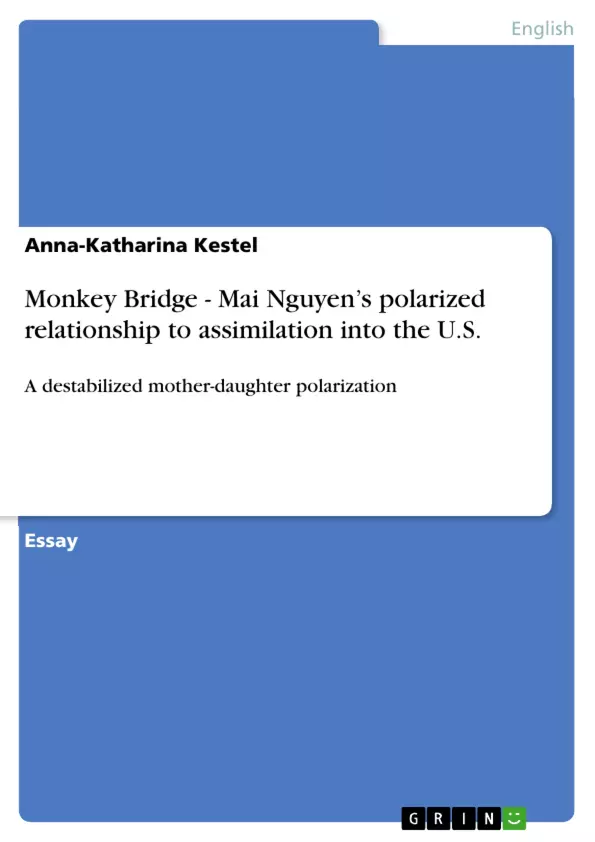In Monkey Bridge, Lan Cao among other things focuses on Mai Nguyen’s polarized relationship to assimilation into the U.S. It is important to know that Mai in contrast to her mother lives in America since she was thirteen-years-old and therefore a teenager which is a difference to her mother in assuming the American culture. In my paper I argue that Mai desires U.S. American norms and values which has consequences in regard to destabilizing the normal mother-daughter polarization. Therefore, within this discussion my essay will examine the juxtaposition between mother and daughter which directly mirrors their desires and criticisms of U.S. norms and values. I will show that the destabilization of the normal mother-daughter polarization consists of three parts including the advanced language knowledge, independence and the social life of Mai compared to her mother Tanh.
Inhaltsverzeichnis (Table of Contents)
- Mai's Desire for Assimilation
- The Destabilization of the Mother-Daughter Polarization
- Advanced Language Knowledge
- Independence
- Social Life
- Switching Roles
- Little Saigon
Zielsetzung und Themenschwerpunkte (Objectives and Key Themes)
This paper explores the polarized relationship between Mai Nguyen and her mother Tanh in Lan Cao's Monkey Bridge. It analyzes how Mai's desire for assimilation into American culture destabilizes the typical mother-daughter dynamic, specifically examining the differences in language skills, independence, and social life. The paper argues that Mai's pursuit of American norms and values leads to a shift in the mother-daughter relationship, where Mai assumes a parental role while Tanh remains deeply rooted in the Vietnamese immigrant community.
- The impact of assimilation on family dynamics
- The role of language in shaping identity and relationships
- The complexities of mother-daughter relationships in immigrant families
- The conflicting desires for both cultural preservation and integration
- The tension between personal aspirations and familial obligations
Zusammenfassung der Kapitel (Chapter Summaries)
The paper examines the linguistic and cultural differences between Mai and Tanh, showcasing Mai's rapid mastery of English and her desire to embrace American culture. The paper then explores how this desire leads to a reversal of roles, with Mai taking on a maternal role towards her mother, who struggles with English and prefers the comfort of the Vietnamese community. Mai's attempts to integrate her mother into American society are met with resistance, highlighting the complex dynamics between cultural identity and familial bonds.
The paper also delves into the significance of Little Saigon as a symbol of the past, highlighting how Tanh finds solace within the Vietnamese community while Mai seeks to break free from this connection. The paper examines the tension between Tanh's desire to preserve their Vietnamese heritage and Mai's longing for a new, American identity, emphasizing how this conflict creates a growing chasm between mother and daughter.
Schlüsselwörter (Keywords)
This paper focuses on the concepts of assimilation, cultural identity, mother-daughter relationships, language acquisition, and immigrant experiences. The study draws upon the themes of cultural conflict, intergenerational differences, and the complexities of navigating a new culture while maintaining ties to one's heritage. Specifically, the paper examines the BiLieF project, a study that examines the impact of language and cultural adaptation on family dynamics.
- Arbeit zitieren
- Anna-Katharina Kestel (Autor:in), 2018, Monkey Bridge - Mai Nguyen’s polarized relationship to assimilation into the U.S., München, GRIN Verlag, https://www.hausarbeiten.de/document/1383409


